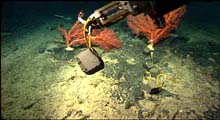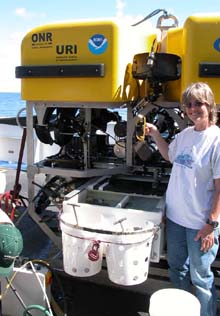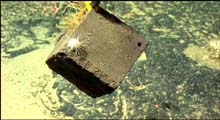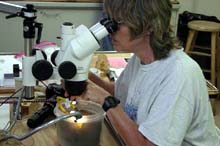
Hercules recovers a settlement block from one of the experimental sites on Manning Seamount. Two large Paragorgia bushes are visible in the background. Click image for larger view and image credit.
Adrift
August 31 , 2005
Susan Mills
Woods Hole Oceanographic Institution
Being on a ship in the middle of the Atlantic really impresses you with the scale of the ocean. We have been at sea for more than three weeks and have seen no land since we left the Azores and few ships - just endless horizon. In case we are tempted to forget how isolated we are, at our weekly fire and boat drills they announce the distance to the nearest point of land. At our most remote site, Lyman Seamount at East Corner Rise, the nearest point of land was Isla do Corvo in the Azores and it was 844 nautical miles away.

Susan Mills of the Woods Hole Oceanographic Institution retrieves a settlement block from the ROV Hercules. Click image for larger view and image credit.
Imagine you are set adrift in the middle of the ocean, in a raft with only a paddle for propulsion. We'll give you all the water you need for a few weeks. Your food is limited to a few emergency rations, plus whatever you can catch along the way. No airplanes or ships will come to rescue you. You are at the mercy of the currents, weather and any predators big enough to eat you. Your only hope of survival is to travel to an island which may be hundreds of miles away. Even if you are lucky enough to come close to land, you may be swept past because you can't paddle against the current.
This is the predicament faced by every seamount larva released into the currents. Many are obliged to spend several weeks in the plankton before they are ready to settle down and begin life on the bottom. During that time they go wherever the currents take them. Since the larvae are tiny - on the order of a millimeter or less in length - they are vulnerable to most predators. Even if they are not eaten and can find enough food, they will die eventually if they do not find someplace to settle.

Several animals are visible on this block, including a white sea urchin, a few feather stars attached near the rope handle and a tiny white snail crawling near the urchin. All of these animals probably crawled onto the rock after settling elsewhere, but there were also several barnacles attached to it which must have arrived as larvae. Click image for larger view and image credit.
If they are lucky, they may be able to stay in the vicinity of their natal seamount for that time and so will have a place to settle when they're competent to do so. If they are very lucky, they may get swept to a new seamount before they are eaten or run out of food. The vast majority will die before they ever find a home.
Two years ago we placed twenty settlement blocks on Manning Seamount, in hopes that some larvae would choose to settle on them. We recovered half of them last year and picked up the remaining ten on this cruise. Most of the animals we found on the blocks could have crawled onto them, such as snails, worms and sea urchins, but a few, including sea anemones, stalked crinoids (relatives of sea stars that live attached to surfaces), barnacles and what may be a tiny coral colony, must have arrived as larvae.

Susan Mills of the Woods Hole Oceanographic Institution examines a settlement block under a microscope. Click image for larger view and image credit.
We have no way of knowing where these larvae came from, though it is probable that most originated somewhere on Manning. However, studying the rate at which colonization occurs on seamounts can give us an idea of how susceptible these populations are to disturbance, such as may occur during bottom trawling. The low number of settlers we have found, even after two years, indicates that these populations would recover slowly even if there were local sources of larvae to recolonize cleared areas.
As we look at images of the beautiful and diverse fauna on these last few dives, it is impossible to help contrasting them with the barren and trawling-scarred summit of Kukenthal Seamount. Once it, too, may have looked like this and perhaps, left undisturbed for long enough, it may again. But we still have the opportunity to protect the New England Seamount coral communities before they are impacted by human activities. I hope we won't waste it.
Sign up for the Ocean Explorer E-mail Update List.
























